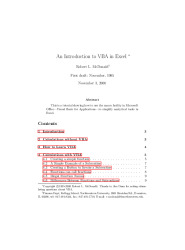Introduction to VBA in Excel - PDF Tutorial
Visual Basic for Applications, Excel's powerful built-in programming language, permits you to easily incorporate user-written functions into a spreadsheet.1
You can easily calculate Black-Scholes and binomial option prices, for example. Lest you think VBA is something esoteric which you will never otherwise need to know, VBA is now the core macro language for all Microsoft's office products, including Word. It has also been incorporated into software from other vendors. You need not write complicated programs using VBA in order for it to be useful to you. At the very least, knowing VBA will make it easier for you to analyze relatively complex problems for yourself.
This document presumes that you have a basic knowledge of Excel, including the use of built-in functions and named ranges. I do not presume that you know anything about writing macros or programming.
The examples here are mostly related to option pricing, but the principles apply generally to any situation where you use Excel as a tool for numerical analysis.
All of the examples here are contained in the Excel workbook VBA.XLS.
Table of contents
- Introduction
- Calculations without VBA
- How to Learn VBA
- Calculations with VBA
- Creating a simple function
- A Simple Example of a Subroutine
- Creating a Button to Invoke a Subroutine
- Functions can call functions
- Illegal Function Names
- Differences Between Functions and Subroutines
Overview of Excel VBA
EXCEL VBA (Visual Basic for Application) is a programming language to use Visual Basic code to run the many features of the EXCEL Application.
A program written in VBA is often called a macro.
Macros can be used to automate repetitive tasks under EXCEL. They can also be used to create dialog boxes to make an application developed under EXCEL more user-friendly.
A macro can be created using the macro recorder, which does not requires no knowledge of the VBA language.
However, a macro created in this way will only run on a set of cells data and product code will not always be very effective. To be able to create macros specific to its needs, effective and interactive, you have to learn how to program in VBA.
Create a Macro
Create a macro MACRO1 which writes in cell A1 the text "AgroParisTech" in bold type and in cell G1 the date of the day in italics.
Before you start recording, you need to ask yourself several questions:
- Think about how to perform manual operations;
- Ask when to start recording. In our case, the selection of cell A1 is part of the record since we want the text "AgroParisTech" is in this cell. If the record does not start with the selection of cell A1, the typed text is written to the active cell.
- Ask when to stop recording.
Question: what to do so that the cell active after the execution of the macro is cell A1?
- Open a new workbook and save it as TEST-MACRO.XLS.
- The cells in a macro are identified by a letter (column) followed by a digit (line), such as cell A1. To make it easier to read the generated VBA code, it is best to choose the same identification of the cells in the workbook in which the macro is saved. If this is not the case, activate the TOOLS OPTIONS command, click on the GENERAL tab and uncheck the L1C1 REFERENCE STYLE box.
- Position the cursor on a cell other than cell A1 on the sheet FEUIL1.
- Activate the command MACRO TOOLS NEW MACRO.
- Type MACRO1 in the MACRO NAME box.
| Size : | 260.632 Kb |
| File type : | |
| Downloads: | 1068 |
| Created: | 2018-05-23 |
Warning: Trying to access array offset on false in /home/tutovnfz/public_html/article.php on line 233
Others VBA Tutorials
Learning access-vba PDF course
VBA Tutorials for professionals
Others related eBooks about Introduction to VBA in Excel - PDF Tutorial
PowerPoint 2010 AdvancedDownload advanced tutorial in PDF about PowerPoint 2010, free course under 201 pages by Stephen Moffat....
Excel 2016 PivotTables and PivotChartsLearn how to use PivotTable and PivotCharts in Microsoft Excel 2016, free training document for download....
Introduction to Excel VBA Macro programmingIntroduction to Excel VBA Macro programming, Learn Excel tools by utilizing them in various cases, Understand the logic and syntax behind Visual Basic programming, which interacts with the Excel interface...
Formulas & Functions in Microsoft ExcelDownload Formulas and Functions in Excel PDF tutorial, free training document by Theresa Scott....
Introduction to Microsoft Word 2013This support shows you in detail all the features of this new version of the popular word Microsoft Word 2013; it is for anyone wishing to discover and deepen all its features....
The Beginner’s Guide to Microsoft ExcelThis is a free Excel PDF tutorial in 11 chapters and 23 pages. This course aims to give students the basics of Microsoft Excel tips and trics. ...
Excel Basics: Microsoft Office 2013This course is intended to beginning computer users. You are only expected to know how to use the mouse and keyboard, open a program, and turn the computer on and off. You should also be familiar with the Microsoft Windows operating system....
Tutorial Access 2016 in PDFDownload free Tutorial in PDF about Microsoft Access 2016 (course, exams and exercises), a complet training document course on 322 pages for beginners by MARY LEMONS....
How to Use Microsoft® Excel®How to Use Microsoft® Excel® The Careers in Practice Series is an textbook appropriate for a course covering Microsoft Excel at a beginner to intermediate level. It is geared toward and will be accommodating for students and instructors with little to no experience in using Microsoft Excel...
Microsoft Excel 2013 courseDownload free Microsoft Office Excel 2013 file under 505 pages,step by step to learn Excel and build your skills , course tutorial training on pdf by Curtis D. Frye....
